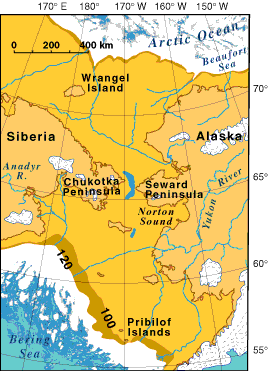America was inhabited by humans long before the first European set foot on the continent. The beginning of civilization in America occurred during the last Ice Age when the nomadic, ancestral peoples of the Americas—the Paleo-Indians—migrated into the current-day continental United States and Canada. Their exact origins, as well as the route and timing of their migrations, are the subject of much scholarly discussion.
The Land Bridge and Migrations
While some researchers may debate the “why” and “when” of migration patterns, all can agree that migration would not have been possible without a glacial epoch. The Last Glacial Maximum (LGM), which occurred between approximately 18,000 and 20,000 years ago, was the last period in the Earth's climate history when ice sheets were at their greatest extension. Extremely cold weather resulted in the formation of vast ice sheets across the Earth's northernmost and southernmost latitudes. As the ice surfaced formed, sea levels dropped worldwide. For thousands of years, the floors of many interglacial shallow seas were exposed, including those of the Bering Strait, the Chukchi Sea to the north, and the Bering Sea to the south.

Bering Land Bridge
It is believed that a small Paleo-Indian population of a few thousand survived the Last Glacial Maximum in Beringia. This group was isolated from its ancestor populations in Asia for at least 5,000 years before expanding to populate the Americas sometime after 16,500 years ago.
During this period, early inhabitants are believed to have traversed the ice into what is now North America. The traditional theory has been that these early migrants moved into the Beringia land bridge between eastern Siberia and present-day Alaska around 11,000 to 25,000 years ago. While there is general agreement that the Americas were first settled from Asia, the pattern of migration, its timing, and the place(s) of origin in Asia of the peoples who migrated to the Americas remain unclear. In the 2000s, researchers sought to use familiar tools to validate or reject established theories, such as the Clovis First / Single origin hypothesis. The archeological evidence suggests that the Paleo-Indians' first dispersal into the Americas occurred near the end of the LGM. The Paleo-Indians are believed to have followed herds of now-extinct Pleistocene megafauna along ice-free corridors that stretched between the Laurentide and Cordilleran ice sheets. It is also thought that they migrated down the Pacific coast to South America either on foot or using primitive boats. Some genetic research indicates secondary waves of migration occurred after the initial Paleo-Indian colonization but prior to modern Inuit, Inupiat, and Yupik expansions.
The First American Civilizations
After multiple waves of migrations, it was several thousand years before the first complex civilizations arose. One of the earliest identifiable cultures was the Clovis culture, with sites dating from some 13,000 years ago. The Clovis culture permeated much of North America and parts of South America. It is not clear whether the Clovis people were one unified tribe or whether there were many tribes related by common technology and belief. As early Paleo-Indians spread throughout the Americas, they diversified into many hundreds of culturally distinct tribes. Paleo-Indian adaptation across North America was likely characterized by small, highly mobile bands consisting of approximately 20 to 50 members of an extended family. These groups moved from place to place as preferred resources were depleted and new supplies were sought.
As time went on, many of these first immigrants developed permanent settlements. With permanent residency, some cultures developed into agricultural societies while others became pastoral. The North American climate stabilized around 8000 BCE to a climate that we would recognize today. Due to the vastness and variety of the climates, ecology, vegetation, fauna, and landforms, ancient peoples migrated and coalesced separately into numerous peoples of distinct linguistic and cultural groups. Some of these cultures developed innovative technology that encouraged cities and even empires. Comparative linguistics shows fascinating diversity, with similarities between tribes hundreds of miles apart, yet startling differences with neighboring groups.